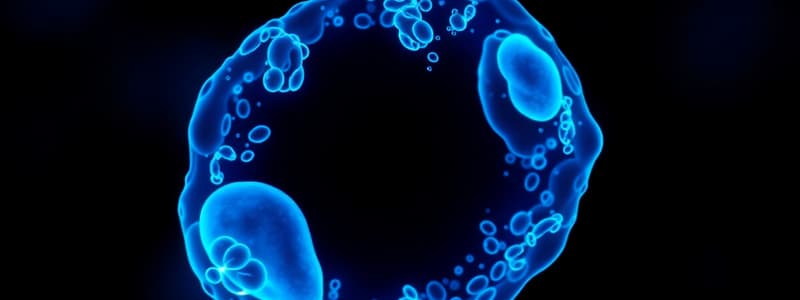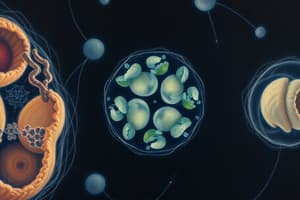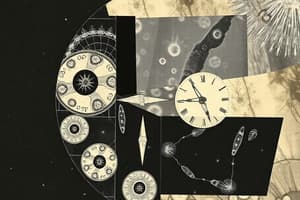Podcast
Questions and Answers
Which phase of the cell cycle is characterized by the duplication of centrosomes?
Which phase of the cell cycle is characterized by the duplication of centrosomes?
- G2 (correct)
- M
- S
- G1
What is the primary role of cyclin-dependent kinases (CDKs) in the cell cycle?
What is the primary role of cyclin-dependent kinases (CDKs) in the cell cycle?
- Degrading microtubules during mitosis
- Activating cyclins to regulate cell cycle progression (correct)
- Inhibiting DNA replication
- Promoting cell death (apoptosis)
If a cell fails to pass the G2 checkpoint, what is the most likely outcome?
If a cell fails to pass the G2 checkpoint, what is the most likely outcome?
- The cell will undergo apoptosis (programmed cell death). (correct)
- The cell will enter mitosis immediately.
- The cell will proceed to the M checkpoint.
- The cell will enter G0 and remain dormant.
What is the primary function of spindle fibers during mitosis?
What is the primary function of spindle fibers during mitosis?
Which of the following is NOT a characteristic of cancer cells?
Which of the following is NOT a characteristic of cancer cells?
How does crossing over during meiosis contribute to genetic variation?
How does crossing over during meiosis contribute to genetic variation?
Which of the following is a key difference between mitosis and meiosis?
Which of the following is a key difference between mitosis and meiosis?
Which phase of the cell cycle is considered the 'resting phase' where cells are not actively dividing?
Which phase of the cell cycle is considered the 'resting phase' where cells are not actively dividing?
Which of the following statements accurately describes the relationship between meiosis and the law of independent assortment?
Which of the following statements accurately describes the relationship between meiosis and the law of independent assortment?
In a dihybrid cross involving two genes, A and B, where both parents are heterozygous (AaBb), what is the expected phenotypic ratio in the F2 generation?
In a dihybrid cross involving two genes, A and B, where both parents are heterozygous (AaBb), what is the expected phenotypic ratio in the F2 generation?
Which of the following is NOT a characteristic of a sex-linked recessive inheritance pattern?
Which of the following is NOT a characteristic of a sex-linked recessive inheritance pattern?
During which stage of the cell cycle does DNA replication occur, leading to a doubling of the chromosome content?
During which stage of the cell cycle does DNA replication occur, leading to a doubling of the chromosome content?
A test cross is performed to determine the genotype of an individual with an unknown genotype for a specific trait. What is the genotype of the individual used for the test cross, and what is the key characteristic of their phenotype?
A test cross is performed to determine the genotype of an individual with an unknown genotype for a specific trait. What is the genotype of the individual used for the test cross, and what is the key characteristic of their phenotype?
Which of the following statements accurately describes the relationship between linked genes and the law of independent assortment?
Which of the following statements accurately describes the relationship between linked genes and the law of independent assortment?
What is the primary function of the chi-square test in genetic research?
What is the primary function of the chi-square test in genetic research?
In a pedigree analysis, if a trait is observed in every generation, but not necessarily in all individuals within each generation, what inheritance pattern is most likely responsible for this observation?
In a pedigree analysis, if a trait is observed in every generation, but not necessarily in all individuals within each generation, what inheritance pattern is most likely responsible for this observation?
Flashcards
G1 Phase
G1 Phase
The cell grows, synthesizes proteins, and produces organelles necessary for division.
S Phase
S Phase
DNA replication occurs, doubling the genetic material with each chromosome consisting of two sister chromatids.
G2 Phase
G2 Phase
The cell continues to grow, synthesizing proteins and checking for DNA errors before mitosis; centrosomes duplicate.
M Phase
M Phase
Signup and view all the flashcards
G0 Phase
G0 Phase
Signup and view all the flashcards
Cyclin-CDK Complex
Cyclin-CDK Complex
Signup and view all the flashcards
Tumor Suppressor Genes
Tumor Suppressor Genes
Signup and view all the flashcards
Crossing Over
Crossing Over
Signup and view all the flashcards
Law of Independent Assortment
Law of Independent Assortment
Signup and view all the flashcards
Haploid vs. Diploid
Haploid vs. Diploid
Signup and view all the flashcards
Punnett Square
Punnett Square
Signup and view all the flashcards
Test Cross
Test Cross
Signup and view all the flashcards
Dihybrid Cross Ratio
Dihybrid Cross Ratio
Signup and view all the flashcards
X-Linked Recessive Inheritance
X-Linked Recessive Inheritance
Signup and view all the flashcards
Chi-Square Test
Chi-Square Test
Signup and view all the flashcards
Mitochondrial Inheritance
Mitochondrial Inheritance
Signup and view all the flashcards
Study Notes
Cell Cycle Phases
- G1 (First Gap Phase): Cells grow, synthesize proteins, and produce organelles needed for division. It's the longest phase. Cells can enter G0 if they don't need to divide.
- S (Synthesis Phase): DNA replication occurs, doubling the genetic material. Each chromosome now has two sister chromatids.
- G2 (Second Gap Phase): The cell continues growing, synthesizes proteins, checks for DNA errors, and duplicates centrosomes before mitosis.
- M (Mitosis): The cell divides, separating sister chromatids into two identical daughter cells.
- G0 Phase: A non-dividing, resting state where cells perform normal functions but don't proceed through the cell cycle (e.g., neurons, muscle cells).
Microtubules and Mitosis
- Spindle fibers, composed of microtubules, attach to kinetochores on chromosomes during mitosis and meiosis.
- Microtubules shorten (depolymerize) to pull chromatids apart in anaphase.
- Microtubules also elongate (polymerize) to push the poles of the cell apart, aiding cytokinesis.
Time Spent in Cell Cycle Phases & G0
- Most cells spend the longest time in G1.
- If a cell never enters S, G2, or M, it is in G0, a state of dormancy.
- Cancer cells often bypass G0 and cycle continuously.
Cyclin-CDK Complexes & Cell Cycle Checkpoints
- Cyclins regulate the cell cycle by activating Cyclin-Dependent Kinases (CDKs).
- G1 Checkpoint (Restriction Point): Checks for DNA damage and cell size.
- G2 Checkpoint: Ensures DNA replication is error-free before mitosis.
- M (Spindle) Checkpoint: Ensures all kinetochores are attached to spindle fibers before anaphase begins.
- If cyclin-CDK is inactive, MPF (Maturation Promoting Factor) is absent, halting mitosis.
Cancer & Tumor Formation
- Oncogenes (e.g., Ras, Myc): Mutated proto-oncogenes increase cell division, leading to uncontrolled growth.
- Tumor Suppressor Genes (e.g., p53, RB1): Normally inhibit cell division; mutations cause unchecked growth.
- Mutations in p53: Lead to cells bypassing apoptosis, allowing damaged cells to divide uncontrollably.
Homologous Chromosomes & Crossing Over
- Homologous chromosomes pair during Prophase I of Meiosis I and exchange genetic material at chiasmata.
- Crossing over increases genetic variation by shuffling alleles.
Law of Independent Assortment & Meiosis
- Occurs in Metaphase I of Meiosis I when homologous pairs align randomly.
- Ensures random inheritance of maternal and paternal chromosomes.
- Does not apply to linked genes that are close together on the same chromosome.
DNA Quantification in Cell Cycle
- Zygote (2N): One chromosome set from each parent.
- S Phase (4N): DNA replication doubles chromosome content.
- Mitosis (2N each): Two identical daughter cells retain full diploid content.
- Gametes (N): Formed via meiosis; haploid (half the original DNA).
Dominant vs. Recessive Alleles
- Dominant vs. Recessive Alleles: Identified via Punnett squares and phenotypic ratios.
- Test Cross: Crossing a homozygous recessive with an unknown genotype (e.g., Aa × aa).
- Monohybrid Cross: One trait, 3:1 ratio in F2 (Aa × Aa → AA, Aa, Aa, aa).
- Dihybrid Cross: Two traits, 9:3:3:1 ratio (AaBb × AaBb).
- Epistasis: One gene modifies another (e.g., coat color in labs).
Sex-Linked vs. Autosomal Inheritance
- Autosomal Dominant: Trait appears in every generation.
- Autosomal Recessive: Skips generations; carriers exist.
- X-Linked Recessive: Males more affected, inherited from carrier mothers (e.g., hemophilia).
- Mitochondrial Disorders: Passed only from the mother to all offspring.
Chi-Square Test for Genetic Ratios
- Compares observed vs. expected results in experiments.
- Formula: X² = Σ [(Ο - Ε)² / Ε]
- Degrees of Freedom (df): Number of categories minus one.
- If p < 0.05, reject null hypothesis (differences are significant).
Meiosis & Gamete Formation in Dihybrid Crosses
- FOIL Method for AaBb × AaBb: Gametes = AB, Ab, aB, ab.
- Creates a 16-box Punnett square.
- Linked genes violate independent assortment (appear together more often).
Pedigree Analysis & Inheritance Patterns
- Autosomal Dominant: Appears in every generation.
- Autosomal Recessive: Can skip generations.
- Sex-Linked Traits: More common in males (X-linked recessive).
- Mitochondrial Inheritance: Passed only from the mother.
- Homozygous dominant cannot always be confirmed, use A? notation.
FRQ Topics & Practice
- Long FRQ: Explain stages of the cell cycle, checkpoints, and their roles.
- Short FRQ: Given a dihybrid cross, determine gametes and phenotype ratios.
- Pedigree Analysis: Identify inheritance type (autosomal, X-linked, mitochondrial).
- Chi-Square Interpretation: Justify whether results align with Mendelian expectations.
Key Terms to Know
- (List of key terms from the provided text – this section is incomplete as the list of key terms isn't included in the provided text)
- (Add specific terms here as needed based on provided text)
Final Tips for AP Exam
- Practice FRQs: Justify answers with biological reasoning.
- Understand Diagrams: Cell cycle phases, meiosis, mitosis, pedigrees.
- Review Experiments: Fruit fly genetics, Mendelian crosses.
- Memorize Key Ratios: 3:1 (monohybrid), 9:3:3:1 (dihybrid), and chi-square interpretation.
- (Additional tips depending on the supplied information)
Studying That Suits You
Use AI to generate personalized quizzes and flashcards to suit your learning preferences.




